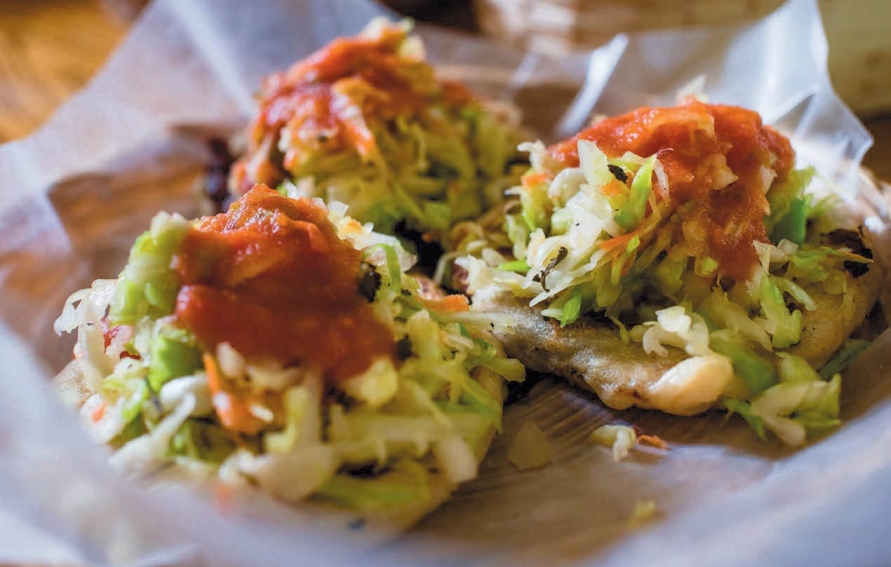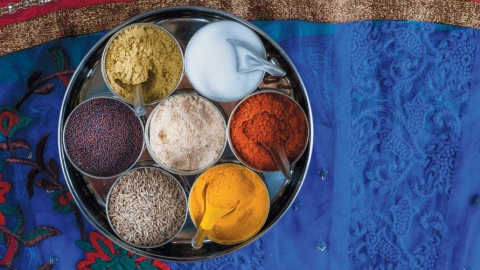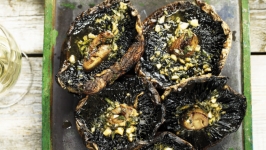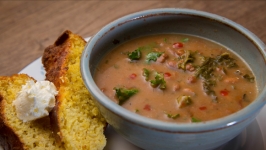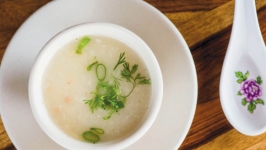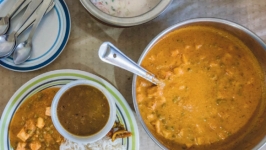Ingredients
- 4 cups corn masa
- 30-ounce can refried beans
- 1 pound mozzarella cheese, shredded
- 2 tablespoons loroco blossoms, chopped canola oil, as needed
- 1 large tomato, roughly chopped
- 1 white onion, peeled and roughly chopped
- 3 cloves garlic, peeled
- 1/2 teaspoon salt
- 1 small green cabbage, cored and thinly sliced
- 2 carrots, peeled and shredded
- 1 jalapeno, seeded and minced
- 1/2 teaspoon salt
- 3 tablespoon apple cider vinegar
Instructions
El Salvadorean Pupusas
1 In a large mixing bowl, stir together the corn masa with enough water to make a dough. The consistency should be very similar to the refried beans.
2 In a separate bowl, stir together the shredded mozzarella and chopped loroco.
3 Preheat a cast iron skillet over medium-high heat.
4 To shape the pupusas, take a golfball-sized handful of the masa dough, and pat it into a disc between your hands. Scoop a tablespoon of the beans, and place in the center of the masa disc, followed by a tablespoon of the cheese mixture. Fold the edges of the dough up and around the filling, easing them together. Gently roll the ball in your hands to seal, and then press into a disc again.
5 Pour a small amount of canola oil into a bowl. Dip your fingers in the oil, and spread it over the pupusa to lightly coat both sides. Shape two more pupusas and then begin to cook them on the preheated skillet. Pupusas are ready to flip when the edges are set and the bottom is lightly golden, 3 to 5 minutes. Cook until the other side is completely set and nicely browned. Flip one more time, and cook the golden side a bit darker.
6 Keep the pupusas warm on waxed paper draped with a towel, in a tortilla warmer, or in an oven set to 200°. Or, do as the El Salvadoreans do, and eat them fresh and hot as soon as they come off the pan.
7 Continue to cook the pupusas, three at a time, until the dough is used up or you have had your fill. Leftover masa dough keeps well for several days in the refrigerator. Store in a tightly sealed container.
Tomato Salsa
El Salvadorean food is not spicy, and this salsa is a mild sauce to enjoy drizzled over the pupusas.
1 Combine tomato, onion, garlic, and salt in a blender or food processor. Blend until smooth.
2 Transfer salsa to a small saucepan, and bring to a boil. Reduce to a simmer, stirring occasionally, until salsa is slightly thickened and darkened.
3 Transfer to a bowl. Cool to room temperature.
Curtido
This slaw is best stirred together several hours before serving, giving the flavors a chance to meld. Serve over the pupusas.
1 Combine cabbage, carrots, and jalapeno in a large bowl.
2 Season with the salt, and add the vinegar, working with your hands to combine.
About this recipe
Flavors of El Salvador: The Tejada Family
When Maria Tejada makes pupusas, the family gathers. Lots of hands join in to stir the beans, mix the Maseca, and shape the dough into perfect little parcels. Even more hands eagerly devour the pupusas fresh off the skillet, drenched with salsa, and topped with crunchy curtido.
Maria and her family moved to Springdale in 2001, and they have brought the food customs of El Salvador with them. They find familiar flavors at the local Salvadorean markets such as the earthy loroco blossoms essential for authentic pupusas. They've discovered substitutes for flavors that are more difficult to come by. Mozzarella is a decent stand-in for the cheese they enjoyed back in El Salvador. But there is no replacement for beans. Bertha Gutierrez, Maria's daughter, says with conviction, "If there are no beans in the house, it feels like there is no food."
But it's more than the flavors of home; it is the way these meals bring their family together. Birthdays, graduations, Saturdays. "Sometimes just for coffee, it's a whole parade," Bertha says. And these things are what make Ozarkansas feel like home: family, food, and friendship. And pupusas, lots of pupusas.

